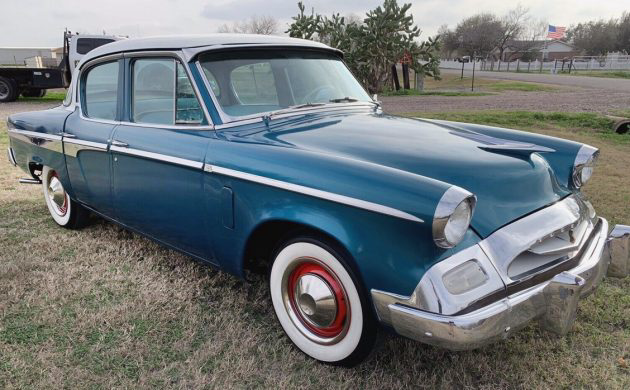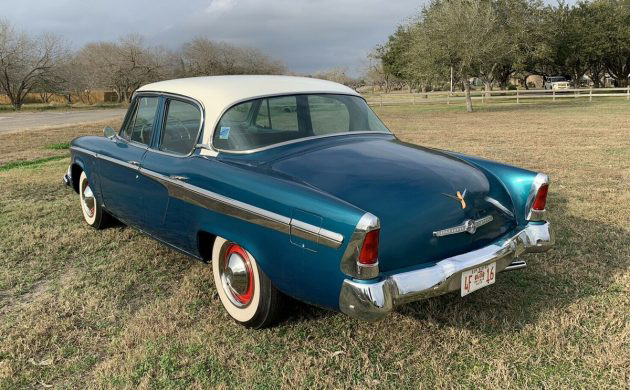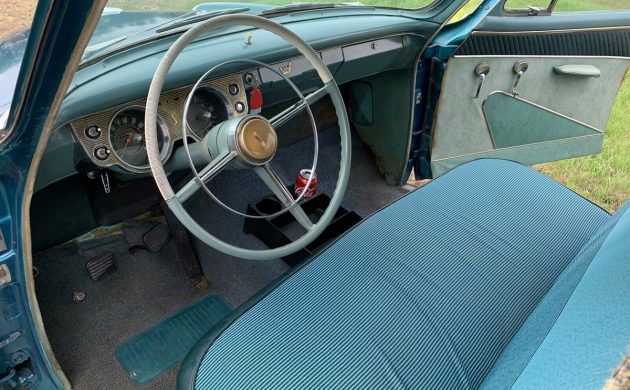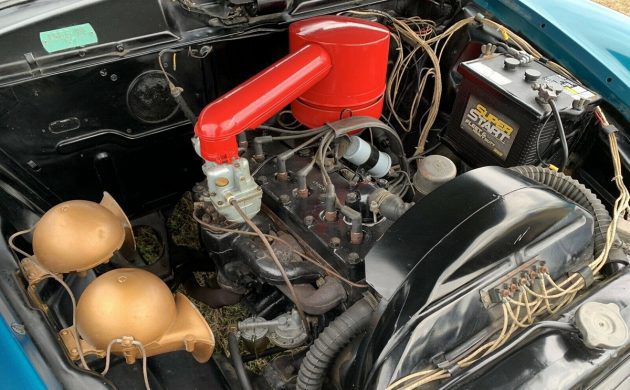This former museum car was restored a couple of decades ago and it sat in a Texas museum for many years. It’s a beautiful top-trim level 1955 Studebaker Champion Regal sedan and it’s still in Texas. The seller has it listed here on eBay in Robstown, Texas and the current bid price is $5,100, but the reserve isn’t met yet. Let’s check it out.
I’m guessing that I’m one of the few people here who would rather have a four-door Champion sedan much more than the two-door coupe? Although the two-door sedan is fantastic, that would be my first choice, if I had a choice. The gigantic chrome grille is always either a thing of beauty or a horrendous design exercise gone wrong. What are your thoughts?
The fourth-generation Champion was made for the model years 1953 through 1956 and they came in three trim levels, the Custom which was a bare-bones car available in solid colors (no two-tone paint), and much of the trim was either not there or it was painted rather than chrome. The mid-level Deluxe had more chrome and trim around the windows and along the sides, along with chrome headlight and taillight surrounds. The top-level Regal such as this car had gobs of chrome and the classic butterknife spear trim on the rear quarters.
The interior looks great other than some loose seat fabric on the driver’s side which would be easy to fix, and quite a bit of the rubber gasket material looks like it may need some help, even the trunk seal. But if that’s the biggest problem with this car, that’s nothing. The back seat looks perfect, but the visible rust on the driver’s door panel worries me a bit. The seller says that as far as they know there is no rust and no evidence of bodywork on this car.
The engine is Studebaker’s 186 cubic-inch L-head six which had 101 horsepower and 152 lb-ft of torque. It’s not a lot of power but it was enough to tug this 2,800-pound car around fairly easily. The seller says that it runs and drives which isn’t the most overly-dramatic assessment of its operating condition, but maybe they’re normally that understated. This car sure looks like a winner. For the record, Hagerty is at $6,000 for a #2 excellent condition car. What will this one sell for?







Someone is badly upside down on the resto cost, even after 20 years. We let my dad’s unrestored ’50 Champion sedan go for $500 6 years ago for that same reason. I love these cars, but from a financial perspective, I’m surprised more of these don’t turn up as rat rods. I kind of wish I’d kept his, threw an SBC at it, and kept the rust.
Not the most desirable Studebaker models. Surprisingly, according to the criteria used by the Old Cars price guide, this would most likely be considered as a #3 condition and valued at $8030. That seems too high to me.
I find it to be a handsome car and one I would gladly drive daily. (I also prefer a four door)
Love the color with the red wheels and white top.
What I don’t like is the door panel. I seem to see things that others don’t.
That door panel looks like the face of a robot monster from Metropolis or something. Two eyes crying and a screaming mouth.
Perhaps I should see someone about that. LOL
Still a pretty car.
I think it’s a pretty nice car. That front bumper / grille setup does look a little gaudy though. I personally like the front to the 53 and 54s better.
Looks like a fair car to restore. Champions had the flathead 6 but the trunk of this car has the Studebaker V8 emblem on it.
Assuming everything works like they should, I can see this also being a daily driver. If I bought it, I’d drive it as often as weather permits safe driving. I love the two tone colour combination. Blue below the windows, with white pillars and roof. Nice combination. :)
Richard,
For some reason, all the Champion Regals had that trunk emblem. It’s actually a V emblem with a gold elongated S, not the number 8.
I’ve never understood why the company made the Champion Regal look like it was a shorter version of the President with that wide chrome trim down the side.
Couple of things to note on this car, First, it has no heater [Texas car], and second, the upper section of the rear doors should be painted to match the roof color, not the dark blue of the body.
Yeah, it’s kind of strange that they didn’t paint up to the paint divider molding on either the door frame or the C-pillar.
It has the correct trunk handle and the S for the Champion. The Commander had the same emblem but with a 8 in it instead of the S
Sorry Richard, but the rear emblem is a big chrome “V” but this one has a big gold “S”, not the “8” as would be on the Commanders and President models.
Beautiful looking car. 1955 has always been my favourite year for Studebaker, at least until the 1959-61 Lark. I’ve always loved the front end appearance of the 1955 Studebaker Champion. This looks like it would either be a good restoration project, or if it runs, a good daily driver.
This car seems to have originally been a V8 Commander, reference the V8 emblem on the trunk and the dash instruments and bezel inside. The champion models had round gauges set in the dash without the large chrome bezel.
Doubtful this was ever a V-8 Commander. All models (including Champions) without the new-for-’55 wrap around windshield had this instrument panel. The sedans with the “Vista View” windshield had the panel arrangement you are referring to. Trunk emblem is a V-S emblem and that’s an S on the gauge bezel. There was another ’55 Commander sedan on BF recently with the Vista View windshield and the alternate instrument panel.
The gold “S” between the instrument pods indicates a Champion. A gold V8 would be there for a Commander.
Always liked Studebakers both because of their styling and in the fifties the two vehicles we had were a 53 Studebaker 2dr Commander coupe and a 47 Studebaker pickup that I learned to drive in on the farm. Like the 53 and 54 front ends and even the bullet fronts of the earlier years but still to this day do not care for the 55 grill and bumper. Always wanted a 53 or 54 coupe and wouldn’t even consider buying one like this in my earlier years but now even with what I think is an ugly grill and 4drs. I would like to own and drive it.
My ALMOST father-in-law wanted me to buy one like this. Driving it scared the doo-doo out of me. Front shocks – both sides – completely shot and the car was only FOUR years old at the time.
I had a 54 Champ with the flat head six. Yellow and blue. After the fact heater added that worked pretty good. I lived in Alaska. It had the “big V” on the trunk. I gave it to a friend to restore. His wife wasn’t so happy with me after that.
The ’53 Lowey couple (with a B pillar, or better without) which continued as the Hawk, with and without fins, was in the opinion of many of us one of the best looking cars of the ’50’s and ’60’s. The attempt to use the design elements on a 4 door sedan was one of the failures. The 4 door Lark of the late 50’s and 60’s was in my opinion success, but Studebaker was then on its way out. This looks like a good buy if you like it, no need to “preserve it”, already evicted from a museum, drive it. If you live in the mountains, it is not overpowered, by any means.
Yes, the C & K bodied cars were glamourous – but practical family haulers were the “bread & butter” of most domestic car output. For ’53, only Nash dared field a second line of cars as well as their stodgy old sedan offerings – the Nashes, the Ramblers AND the Metropolitan line! So for upstart Studebaker to create a whole new line in addition to the sedan line was quite a bold move. Cosmetically, there was VERY little the C-Ks shared with the sedan offerings. Mechanically, of course, there were lots of share parts. It can’t have been that much of a blunder to make the family car variants look related to the sporty jobs. A guy could kinda-sorta look at his Commander 2dr sedan and imagine himself in the pillared coupe edition. They sold plenty of these family rides too. Far more than the C-K variants
The ’55 in question here, is a good-looking car to my eye. The ’53s and ’54s were far and away, more attractive than the stuff from Ford or Chevy. But the “King-of-the-hill” contest between Ford & Chevy that was heating up forced under-capitalized Studebaker-Packard to the sidelines. The ’55s were little changed from the two years prior – and were forced to do with brightwork face lifts to both lines of cars. Fact is, the Lark is not much more than the basic body of ’53 sedans with some different fenders all around. The Hawk line is just ’53 C-K cars with a bit of fresh frosting. Really – when you consider what Stude’s position was – financially – it’s amazing the C-K cars ever were! Even the vaunted Avanti was fresh clothing on a Lark convertible frame.
To my eyes, not the prettiest car.
Hints of the front end of the later Ford Anglia 105E from the UK.
I’ve seen pics of the Ford Anglia, and I find the 55 Studebaker by far, way better looking than the Anglia.
My mechanic always tells me to NEVER buy any museum car. So I am always surprised to see people using that as a sales pitch. This is an interesting car in decent condition. It will be interesting to see where it bids to. I am often surprised.
Bob,
There is some truth to what your mechanic friend says. In the past when someone talked about buying a museum car, I suggested they either visit the museum, or take a good look at how the museum treats the cars on display.
My friend Tom Cammack owned the private, 3 car, Tucker Museum in Alexandria, VA. [Now the Tucker collection in the AACA museum.] I used to help Tom with proper maintenance of the cars. Because they were so valuable, and the costs of insuring them to drive in public were so high, we had to make due with the cars staying in the museum most of the time.
A car that is never driven develops problems most people don’t realize. For example, if a vehicle is simply left in one place for decades, such simple items as wheel bearings can have problems. A wheel bearing has tiny mating surfaces between the inner & outer races, and the rotating bearings inside. On a 4-wheel vehicle, with 2 roller bearings per wheel, that means only a fraction of a point on each bearing is holding up the weight of the car. Tremendous pressure is on those tiny points.
Imagine it this way; Take a marble. Place it between 2 layers of corrugated cardboard box panels. set it all down on a flat solid floor & put a flat board on top. You can move the top board all around without a problem. But if you were to stand on the board, that marble will crush both layers of the cardboard.
The same problem happens to wheel bearings, but on a slower and more microscopic level. Eventually if the bearing is not rotated, the grease protecting the surfaces is squeezed out, resulting in direct metal to metal contact. With time, that bare metal develops a rough surface, known as spalling. When the bearing again begins to be used on a regular basis, the bearing begins a fairly rapid deterioration cycle.
I advised Tom to move the Tucker cars a few inches backwards every couple of months, then after 6 months, move them forward again. I also had worked up a basic “workout routine” for the cars in general. If a set of parts could be moved against each other, then do so, even if it was only a little amount. Steering systems, linkages of all types. window winding parts, door latches and opening levers, key locks. Tom used DOT5 [silicone] brake fluid, so we weren’t that worried about brake fluid loss or the fluid attracting moisture like DOT3 or 4 does. We did gently press the brake pedal down, but always made sure all the brake parts were returning to the “rest” position. These are the ways a good museum maintains their vehicles.
I’ve also visited “so-called” car museums, where I saw vehicles with flat tires, sometimes sitting in dirt floors. Cars covered with dust because no one cared about cleaning the cars, not to mention making sure the cars were in good operating condition. Some of these museums were thrown together in a tourist area, used to make a profit, without any consideration on the care of the cars.
I’m not going to name any places, but a few years ago I visited a car museum in Delaware, near Dover Air Force Base. This “Museum” consisted of about 150 cars, from the 1930s to the 1980s, parked helter-skelter around the guys home, and an adjoining property with a large old warehouse building that leaked when it rained. None of the cars had run in years, a 1963 Valiant had sat so long a tree had grown up along side the rear bumper, pushing it upwards. Every car there, with the exception of a few recent buys or about a dozen inside the building, needed a total restoration, a few were parts cars at this point.
In the 1970s I visited one museum with hundreds of vehicles displayed in rickety wooden shacks, with chicken wire between the visitor walkways and the cars, and it was painfully obvious that once a vehicle went on display it was never touched again.
Given a choice of where to buy a museum vehicle, and being told it was in great condition when it was put on display, which museum would you prefer? [And NO, just because the first museum was devoted to Tuckers, is not a reason to buy only from that museum!]
Sometimes you don’t have a choice when buying what you want, so you need to look carefully at the vehicle, especially if it cannot be driven for a test ride. I bought a Tatra T-603 that had been in a museum for decades. Those cars have McPherson struts on all 4 wheels. The struts had not been “exercised” and the pistons were almost frozen. By the time the car went from Europe to the US, all 4 struts had started to seize from lack of lube. Fortunately they are refillable, but as I bought it from the USA, I didn’t have the ability to check closely. But that was OK, I was buying it with USA cash Dollars right after the fall of the Iron Curtain, very CHEAP, so it didn’t matter!
Thank you for the very interesting and informative post. I learned something today!!
I have not heard the term ‘Spalling’ for many years. My father was a heavy equipment mechanic and he used that term………….
I totally agree. A car has to be driven frequently in order to exercise it. A car has to be serviced as often as possible in order to keep a car running safely. I’ve heard of cars that were only once or twice since being purchased. They were never started or driven around the neighbourhood, or anywhere at all throughout its existence. That can’t be healthy for a car. You’d think even a museum would run a car from time to time. I’d rather buy a car, however old it may be, that’s been driven a lot, but is also carefully driven, but is also service and maintained as often as needed. However good it looks on the surface, it doesn’t do a car any good if it isn’t driven.
Had to watch the hood hinges keep lubed as would drag and then could bend to hood. Also watch the trunk lid gasket, would leak and rain would flood it.I had a 56 Power Hawk trunks lid leaked but a new gasket fixed it.
JohnJ,
Studebaker cars 1953-58, and hawks thru 64, have hoods that are subject to metal fatigue at the hinge points, where the hinge attaches to the hood panel. It is EXTREMELY important that when opening a hood, especially the Hawk versions, that the person opening the hood PULL FORWARD and upward. This helps ensure the hood edges won’t fail and the hood bend. Once bent, it’s damn near impossible to repair.
When it comes to weather strips, I’ve never cared for Studebaker’s method of installing the rubber in the channel on the body, rather than on the closing body part like the door or trunk lid. With the rubber filling the channel, there is no place for dirt to wash out during rain, and as the rubber deteriorates, this means it will be far easier for water to gain entry.
On Studebaker door weatherstrips, the rubber strip that seals the bottom of the door is mounted to the body, under the sill’s chrome strip. As people get in and out of the doors, their shoes scrape against that rubber, and the rubber is quickly damaged. In addition, looking at a cross section of that rubber extrusion shows it’s a shallow “U” shape, and the center of that “U” shape ends up with dirt and stones in it, contributing to the rubber’s quick decline.
The front end of this car might have been the “inspiration” for the design of the Daimler SP250 Dart. It looks a lot more appropriate here than on the Daimler, which in my opinion is one of the ugliest cars ever built, although with the V8 engine the SP250 is great to drive. It’s like the Eiffel Tower – the only way to avoid seeing the Daimler is to be driving it.
My father bought a ’55, 4 door Commander, 3 “on the tree”, in Royal Windsor Blue with a Studebaker designed and built V8. Lots of power for high school but I was shortly distraught as GM came out with their “square” Chevrolets and our “new” car looked old fashioned. It still out dragged the first aluminium block compact Buick Special. Had it ’til ’62. In the interim fins had come and gone and it’s’ shape was back in style.
I have vivid memories of this model, as at 15 years old (early 70’s) I was prowling a junkyard looking for parts for my ’53 Starliner. The yard was full of 4 door post ’57 Chevies, bathtub Nashes, Studes, Hudsons, etc. You couldn’t find a 2 door HT of any make, as they didn’t get junked unless wrecked. I’ll bet there were 150 cars. It was in Pensacola FL near the old fairgrounds.
At the time I hated these, the styling looked very forced and out of kilter. But seeing one in this condition 50 years later, I have to say it’s grown on me a bit.
I suspect this car was from Dick’s Classic Car Museum in San Marcos, TX, between Austin and San Antonio. I went there twice before it closed in 2018 though I don’t recall this car. https://www.tripadvisor.com/Attraction_Review-g56618-d1838104-Reviews-Dick_s_Classic_Garage-San_Marcos_Texas.html
Such a sad looking car.